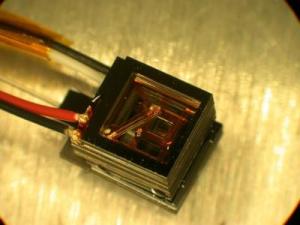Oct 15 2010
Researchers from the National Institute of Standards and Technology (NIST) and the German national metrology institute have used NIST's miniature atom-based magnetic sensor to successfully track a human heartbeat, confirming the device's potential for biomedical applications.
Described in Applied Physics Letters, the study is the first to be performed under conditions resembling a clinical setting with the NIST mini-sensors, which until now have been operated mostly in physics laboratories. The new experiments were carried out at the Physikalisch Technische Bundesanstalt (PTB) in Berlin, Germany, in a building described as having the world's best magnetic shielding—necessary to block the Earth's magnetic field and other external sources from interfering with the high-precision measurements. PTB has an ongoing program in biomagnetic imaging using human subjects.
 NIST's miniature magnetic sensor is about the size of a sugar cube. The lid has been removed to show the inner square cell, which contains a gas of rubidium atoms.
NIST's miniature magnetic sensor is about the size of a sugar cube. The lid has been removed to show the inner square cell, which contains a gas of rubidium atoms.
The NIST sensor—a tiny container of about 100 billion rubidium atoms in gas form, a low-power infrared laser, and optics—measured the heart's magnetic signature in picoteslas (trillionths of a tesla). The tesla is the unit that defines magnetic field strength. For comparison, the Earth's magnetic field is a million times stronger (measured in millionths of a tesla) than a heartbeat, and an MRI machine uses fields several million times stronger still (operating at several tesla).
In the experiments at PTB, the NIST sensor was placed 5 millimeters above the left chest of a person lying face up on a bed. The sensor successfully detected the weak but regular magnetic pattern of the heartbeat. The same signals were recorded using the "gold standard" for magnetic measurements, a SQUID (superconducting quantum interference device). A comparison of the signals confirmed that the NIST mini-sensor correctly measured the heartbeat and identified many typical signal features. The NIST mini-sensor generates more "noise" (interference) in the signal but has the advantage of operating at room temperature, whereas SQUIDs work best at minus 269 degrees Celsius and require more complicated and expensive supporting apparatus.
A spin-off of NIST's miniature atomic clocks, NIST's magnetic mini-sensors were first developed in 2004. Recently, they were packaged with fiber optics for detecting the light signals that register magnetic field strength. In addition, the control system has been reduced in size, so the entire apparatus can be transported easily to other laboratories.
The new results suggest that NIST mini-sensors could be used to make magnetocardiograms, a supplement or alternative to electrocardiograms. The study also demonstrated for the first time that atomic magnetometers can offer sensing stability lasting tens of seconds, as needed for an emerging technique called magnetorelaxometry (MRX), which measures the magnetization decay of magnetic nanoparticles. MRX is used to localize, quantify and image magnetic nanoparticles inserted into biological tissue for medical applications such as targeted drug treatments. Further tests of the NIST sensors at PTB are planned.
Source: http://www.nist.gov/